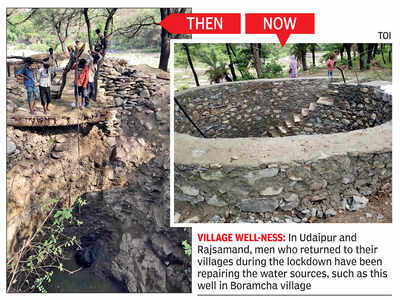
When work dried up in the big cities during the lockdown, many thousands of men from Rajasthan’s Udaipur and Rajsamand districts trudged back home. Vijay Ram, a 28-year-old from Kuchauli panchayat in Rajsamand, says just thinking about the long journey gives him the shivers. He’s not going back “at least this year.” And he has a good reason to stay home now.
In the two months since they returned, Vijay Ram and others like him have changed the face of their villages. There’s piped water at last, long-neglected wells have been repaired, and agriculture has become more than a means of subsistence. “Earlier, we only grew grains, but this year we have sown vegetables also.”
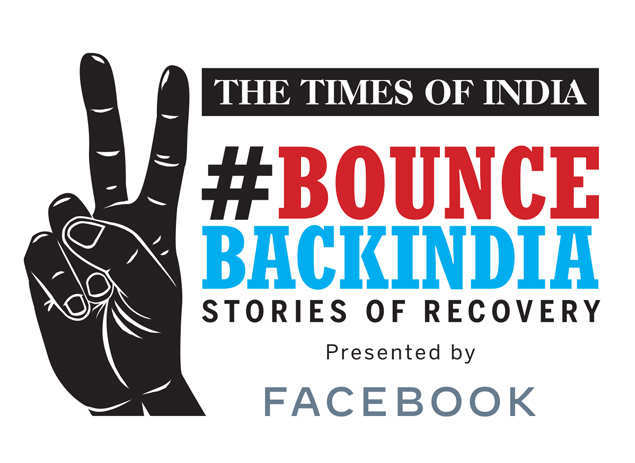
Tourists visiting Udaipur and Rajsamand take back memories of their rugged hills but life for the locals can be hard, especially in the tribal villages where water is scarce. That’s why up to 95% of men in some blocks migrate to Mumbai or Surat for work.
Read more from this series
The workers who returned home because of the lockdown didn’t have to worry about rent anymore, but they still had to put bread on the table. “At that time, it was hard to say what was worse, staying on in the city or returning home. We were out of work, money and hope in both places,” says 35-year-old Tola Ram from Udaipur’s Boramcha village.
The returnees decided not to sit around and lament their fate. “We began with efforts to arrange food and water in the village,” says Tola Ram. In Kanela, another village in Udaipur, they turned their attention to community works. The village didn’t have a water tank, so they made many phone calls to the collector’s office and the block development officer, says Ganesh Naal Gamethi, a resident.
“Our perseverance paid off when the village got its first 5,000-litre overhead tank. Then came the taps. Until recently, women fetched water from wells or used handpumps. The two taps installed in our village have made life a bit easier,” Gamethi says proudly.
In other villages, the returnees are digging new wells, repairing old ones and raising crops with the new sources of water. “This is a tribal belt where families have low access to resources like drinking water, sources of irrigation, etc,” says Saloni Mundra, knowledge and programme support executive at the NGO, Aajeevika Bureau, which is supporting the projects financially.
The NGO’s help and the hard work put in by the people have transformed many villages in two months. Vijay Ram says they now use a pump to irrigate their fields. He expects a surplus that can be sold in the market. Putting bread on the table does not seem so hard anymore.
(This story is part of a series in association with Facebook. Facebook has no editorial role in this story.)
In the two months since they returned, Vijay Ram and others like him have changed the face of their villages. There’s piped water at last, long-neglected wells have been repaired, and agriculture has become more than a means of subsistence. “Earlier, we only grew grains, but this year we have sown vegetables also.”

Tourists visiting Udaipur and Rajsamand take back memories of their rugged hills but life for the locals can be hard, especially in the tribal villages where water is scarce. That’s why up to 95% of men in some blocks migrate to Mumbai or Surat for work.
Read more from this series
The workers who returned home because of the lockdown didn’t have to worry about rent anymore, but they still had to put bread on the table. “At that time, it was hard to say what was worse, staying on in the city or returning home. We were out of work, money and hope in both places,” says 35-year-old Tola Ram from Udaipur’s Boramcha village.
The returnees decided not to sit around and lament their fate. “We began with efforts to arrange food and water in the village,” says Tola Ram. In Kanela, another village in Udaipur, they turned their attention to community works. The village didn’t have a water tank, so they made many phone calls to the collector’s office and the block development officer, says Ganesh Naal Gamethi, a resident.
“Our perseverance paid off when the village got its first 5,000-litre overhead tank. Then came the taps. Until recently, women fetched water from wells or used handpumps. The two taps installed in our village have made life a bit easier,” Gamethi says proudly.
In other villages, the returnees are digging new wells, repairing old ones and raising crops with the new sources of water. “This is a tribal belt where families have low access to resources like drinking water, sources of irrigation, etc,” says Saloni Mundra, knowledge and programme support executive at the NGO, Aajeevika Bureau, which is supporting the projects financially.
The NGO’s help and the hard work put in by the people have transformed many villages in two months. Vijay Ram says they now use a pump to irrigate their fields. He expects a surplus that can be sold in the market. Putting bread on the table does not seem so hard anymore.
(This story is part of a series in association with Facebook. Facebook has no editorial role in this story.)
Download
The Times of India News App for Latest India News

Coronavirus outbreak
Trending Topics
LATEST VIDEOS
India
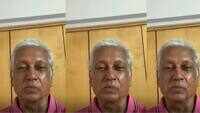 Kargil Vijay Diwas: Cricketer Jimmy Amarnath pays tribute to soldiers with this beautiful song
Kargil Vijay Diwas: Cricketer Jimmy Amarnath pays tribute to soldiers with this beautiful song 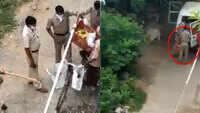 Cops seen snatching banana crate from fruit vendor, video viral
Cops seen snatching banana crate from fruit vendor, video viral  ‘Hanuman Chalisa’ will definitely eradicate coronavirus, it’s our belief: Pragya Thakur
‘Hanuman Chalisa’ will definitely eradicate coronavirus, it’s our belief: Pragya Thakur 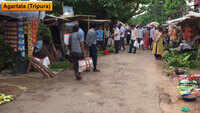 Locals stock up essential items ahead of 3-day total lockdown in Tripura
Locals stock up essential items ahead of 3-day total lockdown in Tripura  Scientists decode how coronavirus molecules 'camouflage' in host cell; may lead to drug development
Scientists decode how coronavirus molecules 'camouflage' in host cell; may lead to drug development  Kargil Vijay Diwas: PM Narendra Modi pays tribute to our brave soldiers
Kargil Vijay Diwas: PM Narendra Modi pays tribute to our brave soldiers
More from TOI
Navbharat Times
Featured Today in Travel
Quick Links
Coronavirus in MumbaiCoronavirus in KolkataCoronavirus in HyderabadCoronavirus in DelhiCoronavirus in BangaloreCoronavirus symptomsCoronavirus in IndiaWhat is CoronavirusCoronavirus NewsSolar EclipseNPRWhat is NRCCAB BillCAB and NRCRTI BillPodcast newsLok SabhaShiv SenaYSRCPCongressBJP newsUIDAIIndian ArmyISRO newsSupreme Court
Get the app



